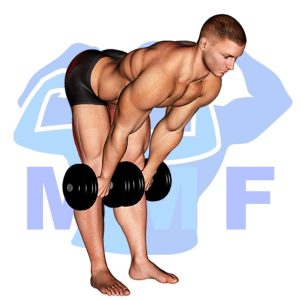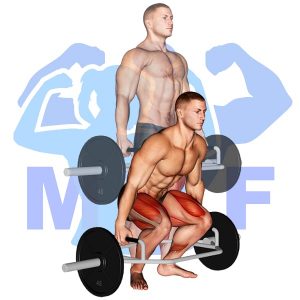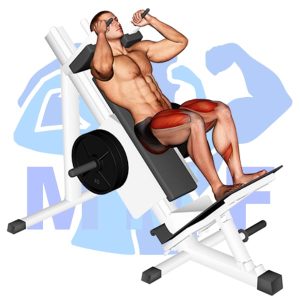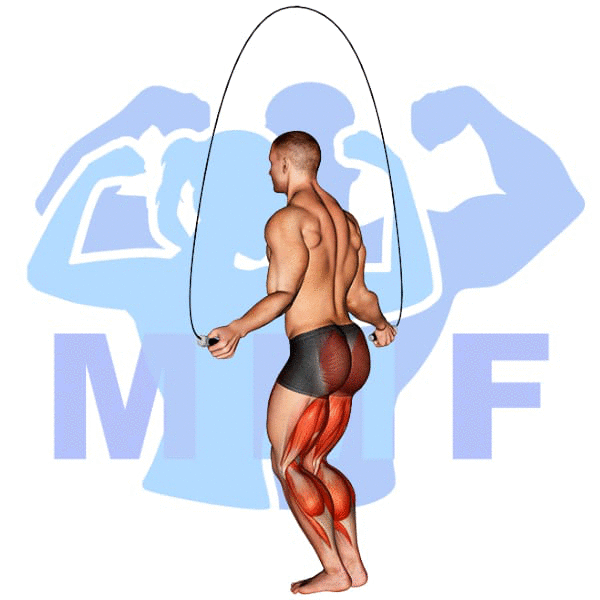Are you struggling with perfecting the lever deadlift? Don’t worry, you’re not alone. Many lifters find it challenging to execute this particular movement with proper form and technique. The culprit behind this struggle is often a lack of understanding or awareness of how to engage the proper muscles. Rather than getting discouraged, take heart knowing that this is a common issue among beginners and even some seasoned lifters. In this blog post, I’ll walk you through all the steps to master the lever deadlift and finally bring some confidence to your lifting game.
Lever Deadlift (Machine) Summary
- Primary Muscles: Gluteus Maximus
- Secondary Muscles: Quadriceps, Adductor Magnus, Soleus
- Equipment: Deadlift Machine
- Mechanics Type: Compound
- Force: Pull
- Utility: Basic

Lever Deadlift (Machine) Instructions
- Stand with feet hip-width apart.
- Place hands slightly wider than shoulder-width apart on the bar.
- Bend your knees and grip the bar.
- Keep your back flat, chest up, and core tight.
- Drive your feet into the floor as you lift the bar.
- Stand up straight and squeeze your glutes at the top.
- Lower the bar back to the ground in a controlled manner.
- Repeat.
Video Tutorial
Lever Deadlift (Machine) Muscles
Target (Agonist)
Synergists
- Adductor Magnus
- Quadriceps
- Soleus
Dynamic Stabilizers
Stabilizers
- Erector Spinae
- Levator Scapulae
- Rhomboids
- Trapezius – Middle
- Trapezius – Upper
Antagonist Stabilizers

Benefits of Lever Deadlift (Machine)
The Lever Deadlift (Machine) is an effective exercise for targeting the Gluteus Maximus, one of the key muscles in the lower body. Performing the Lever Deadlift (Machine) will help strengthen the glutes, which will in turn help with activities such as walking, running and jumping. Additionally, performing this exercise regularly can help to improve posture and reduce back pain as it works to strengthen the glutes and core muscles, which are essential for proper posture. It can also help to increase overall strength and power as it works to improve balance, coordination and stability. Finally, the Lever Deadlift (Machine) can be used to increase muscle mass and size in the glutes, leading to an improved physique.
Tips for Performing Lever Deadlift (Machine)
The Lever Deadlift is a great exercise that can help you get fit and build strength. If you’re looking to take your fitness to the next level, these tips can help you get the most out of the Lever Deadlift. With proper form and technique, you can reap the benefits of this exercise and achieve your fitness goals.
- Maintain proper form: To get the most out of the lever deadlift, it is important to maintain good form throughout the exercise. The back should be kept straight and the shoulders should be pulled back. Engage the core throughout the exercise to help stabilize the body and keep the spine in a neutral position.
- Use a light weight: When performing lever deadlifts, it is important to use a weight that is appropriate for your level of fitness. Start with a light weight and increase it gradually as you become stronger and more comfortable with the exercise. This will help prevent injury and ensure you get the most out of the exercise.
- Keep your feet planted firmly: It is important to keep your feet firmly planted on the floor when performing lever deadlifts. Keeping your feet firmly planted will help you stay balanced and in control throughout the exercise, allowing you to get the most out of it.
Benefits and Tips Video
Frequent Mistakes To Avoid
It is important to be aware of potential mistakes when performing the Lever Deadlift exercise in order to get the most out of your workout and avoid any potential injuries. Below are some common mistakes to be aware of and avoid when doing the Lever Deadlift.
- Not maintaining proper posture: it is important to keep your spine neutral throughout the exercise, hinging from the hips instead of the back. If you round your back, you put yourself at risk of developing a back injury.
- Not engaging your core: Your core is what will help to stabilize your body throughout the exercise, so make sure to engage it for proper form and to maximize the benefit of the exercise.
- Lifting too heavy: It is important to lift a weight that you can comfortably handle and control. If the weight is too heavy, you may end up using momentum to lift it and risk injury.
Find More Machine Exercises Here
Variations and Complementary Exercises
These are just a few of the many variations, complementary, and alternative exercises for the Lever Deadlift (Machine) that can be used to target similar muscle groups. Try out some of these exercises to supplement your Lever Deadlift (Machine) routine and take your workout to the next level.
Dumbbell Straight Leg Deadlift

The Dumbbell Straight Leg Deadlift is a great complementary or alternative exercise to the Lever Deadlift (Machine). This exercise focuses on strengthening the muscles in the lower back, hamstrings, and glutes. It is an excellent exercise for developing a strong posterior chain and helping to prevent lower back injuries. The difference between the two exercises is that the Lever Deadlift (Machine) is a seated exercise, while the Dumbbell Straight Leg Deadlift is performed while standing. Both exercises involve lowering the weight with control and engaging the core muscles. The Lever Deadlift (Machine) works more on the quadriceps and glutes, while the Dumbbell Straight Leg Deadlift works more on the hamstrings and lower back. Both exercises are effective for building strength and should be incorporated into any strength training program.
Dumbbell Stiff Leg Deadlift

The Dumbbell Stiff Leg Deadlift is an excellent complementary or alternative exercise to the Lever Deadlift (Machine). It is a great way to target the same muscles used in the Lever Deadlift, namely the glutes and hamstrings, but with a slightly different motion. The Dumbbell Stiff Leg Deadlift requires you to lower yourself down with a flat back, while keeping your knees slightly bent, and then lift back up using your hips and glutes while keeping your back flat and chest out. This exercise provides a great way to build strength and muscle size in your lower body without having to use a machine.
Smith Machine Deadlift

The Smith Machine Deadlift is a great complementary or alternative exercise to the Lever Deadlift (Machine). It is an effective way to target the same muscle groups but with a slightly different movement pattern. The Smith Machine Deadlift requires you to keep your spine in a neutral position, while the Lever Deadlift (Machine) requires you to round your back and use momentum to lift the weight. The Smith Machine Deadlift allows you to control the weight more effectively and keeps your spine in a safe position, making it a great choice for those looking for a more controlled lift.
Check Out These Top Machine Exercises
Band Stiff Leg Deadlift

The Band Stiff Leg Deadlift is a great complementary or alternative exercise to the Lever Deadlift (Machine). This exercise works the same muscles as the Lever Deadlift, but instead of using a machine, you use a resistance band. The band provides a greater range of motion than the Lever Deadlift, allowing you to work your hamstrings and glutes more effectively. Additionally, the band allows for more flexibility, allowing you to adjust the resistance to your own personal strength level. This exercise can also be done at home or in the gym and requires minimal equipment.
Trap Bar Deadlift

The Trap Bar Deadlift is a great complementary or alternative exercise to the Lever Deadlift (Machine). It is an effective full body exercise that targets the glutes, hamstrings, quadriceps, core, and back. It is an excellent exercise to increase lower body strength and power as well as improve overall body balance and coordination. The Trap Bar Deadlift allows you to lift heavier loads, while still maintaining proper form. This exercise is also a great way to target your posterior chain and can be used as a substitute for the Lever Deadlift (Machine).
Barbell Romanian Deadlift From Deficit

The Barbell Romanian Deadlift From Deficit is a great complementary exercise to the Lever Deadlift (Machine) as it helps to increase the range of motion and work the muscles from a greater range. This exercise works the muscles in the glutes, hamstrings, and back, making it an effective alternative to the Lever Deadlift (Machine) for those looking to develop strength and size in those areas. The Barbell Romanian Deadlift From Deficit also helps to improve balance and posture, which can help to reduce the risk of injury when performing other exercises.
Find More Glutes Exercises Here
Opposing Complementary Exercises
In order to properly balance the muscles used in the Lever Deadlift (Machine) exercise, it is important to also perform exercises that target the opposing muscle groups. These exercises will help to ensure that your body is working in balance and reduce the risk of injury. The following exercises are recommended to complement the Lever Deadlift (Machine) and work the opposite muscle groups:
Sled Hack Squat

Sled Hack Squat is an effective exercise for targeting the quads and glutes, two of the primary muscle groups used in Lever Deadlift (Machine). This exercise is a great complement to Lever Deadlift (Machine) because it uses the opposing muscle group to increase muscular strength and size. It is also a great way to increase balance and stability, as the sled Hack Squat requires the user to maintain a balanced position while squatting. Additionally, this exercise helps to build power and explosiveness, which are key components of any successful strength training program.
Sled Full Hack Squat

The Sled Full Hack Squat is a great complement to the Lever Deadlift (Machine), as it works the opposing muscle groups. This exercise focuses on the quadriceps, which are the main muscles used when pushing up from the bottom of a squat. The Lever Deadlift (Machine) works the hamstrings and glutes, which are the main muscles used when pulling up from the bottom of a deadlift. By performing both of these exercises in succession, you can ensure that all the major muscle groups involved in lifting are getting a full workout.
Smith Machine Hack Squat

The Smith Machine Hack Squat is an excellent complementary exercise to the Lever Deadlift (Machine). By using the opposing muscle group, the Smith Machine Hack Squat helps to develop the quads and glutes while the Lever Deadlift works on the hamstrings and lower back. This combination of exercises allows for a well-rounded lower body workout that targets both the front and back of the legs. The Smith Machine Hack Squat also requires a greater range of motion than the Lever Deadlift, allowing for increased flexibility and improved posture.
Lever Deadlift: Unleash Your Full Strength
Are you looking to take your strength training to the next level? Look no further than the lever deadlift. This powerhouse move targets multiple muscle groups and requires immense core stabilization. By mastering the lever deadlift, you’ll unleash your full potential for strength and power, turning heads and earning respect in the gym. But don’t jump right in – proper form and gradual progression are key to avoiding injury and maximizing results. Get ready to push yourself to new heights with the lever deadlift.
References: Wikipedia | ExRx.net | PubMed.gov | Comprehensive List of Glutes Machine Exercises




